Airplane plus ship. Part of 2
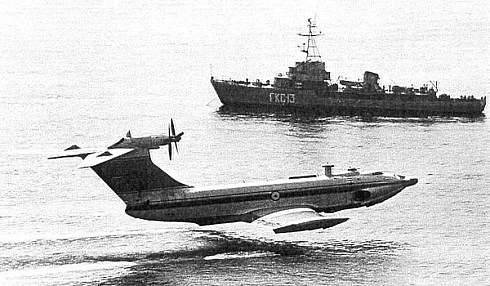
It was the creation of a “flying ship” that the princess sang about. The hydrofoil of a ship is shaped like an airplane wing. The lower part is flat, the upper one has a convex surface. Water flows around the wing both from below and from above, but the speed of these two streams is different, therefore a certain depression of water mass is created under the wing, and the water pressure from below forms a powerful lifting force.
The designers determined the strict dependence of lift on the speed of the ship. It was a very important discovery. Speed itself has become a regulator of the lift of the wings. A certain speed allowed the ship not to dive deep and jump out of the water, but to fly along an invisibly drawn line.
The shape of the wings, the depth of their immersion in water, the angle of inclination, or, as the designers say, the “angle of attack of the wings” —all this determined the steady flight of the vessel.
Only after conducting dozens of experiments, the designers found the optimal solution, the only true ratio of shape, speed and angle of attack of the wings, which was necessary for the “Rocket”.
When something completely new is created, difficulties and unresolved technical problems lurk at every step. In the experimental workshop we were convinced of this very quickly.
The appearance of the winged ship! Lift a regular boat out of the water, and you will be amazed at its ridiculous appearance. The “Rocket” building was all coming out of the water, for this new movement it was necessary to find new architectural forms.
When flying, the “Rocket” hull did not touch the water, but high speed generated air resistance. The ship was supposed to get the most streamlined. For a long time in the experimental workshop they could not find the necessary sharp lines for the bow of the ship.
But a special torment brought the control room. If it were possible, the designers would have removed the cabin from the deck at all, hid it in the body of the ship, as they do on airplanes. How much metal was spent making ten variants of this cabin. And every time it seemed to the designers that the deckhouse on the upper deck did not fit in well with the general, rapid “Rocket” circuit.
The riveted duralumin hull of the ship required particularly careful finishing - the slightest scratch, a dent was considered a marriage on the lead ship. When the hull was ready, the engine was delivered to the workshop, and its finishing was coming. Many of the failures with cruise ships in the past were due, among other things, to the fact that at that time there were no engines that, at high power, would have a relatively light weight.
Winged ship and bulky steam engine are incompatible things.
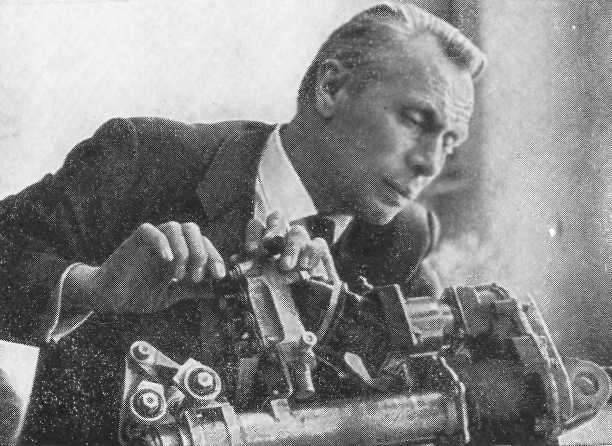
The work went on in three shifts. In early May, the “Rocket” was decided to be launched for the first time. The ship was still without felling, was not completed, but it was important to check its basic seaworthiness.
Only recently, ice passed on the Volga, and the flood was advancing on the shore of the Sormovsky backwater. When the engine pulled on the “Rocket” platform to the very shore, its wheels went into the water. The water splashed even at the foot of the tower cranes, which were supposed to transfer the ship to the water.
I had to push a floating crane to the shore, he lifted the ship into the air, sailed a little, and only then the “Rocket” found itself on the Volga. This turned out to be troublesome, and only in the evening tired, drenched shipbuilders climbed onto the deck of the "Rocket", according to ancient custom, smashing a bottle of champagne on its wing.
However, the first run of the vessel alerted the designers. The “rocket” was moving in the water uncertainly, its wings were walking too close to the surface, the ship was shaking on a small wave.
Wing angle of attack! That's what it was. Attack angle! Defining it, the designers have done hundreds of experiments with models. But on the first test of a full-scale ship, it turned out that the angle of attack is great, and more than necessary, the lift capacity of the wings.
Again, the floating vessel lifted above the water and carried it to the railway platform. Now it was necessary to remove the wings in the workshop, reduce the angle of attack and do it with such care and precision so as not to be mistaken not only in degrees of angle, but also in minutes.
26 July early in the morning "Rocket" again came out of the factory backwater, so that on the same day, fifteen hours later, go to the landing stage of the Khimki river station in Moscow. Even the most high-speed express trains passed 900 kilometers from Gorky to Moscow in only three days.
The Gorodtsu "Rocket" flew so fast that they did not have time to prepare the gateway, and the ship had to swim for twenty minutes near the hydropower station, until the lock gates rose, opening the way.
Then the ship went to the expanses of an artificial reservoir. Gaining speed, he rose on the wings, and the first captain of the ship, Viktor Poluektov, headed for Moscow.
Fourteen running hours, an hour earlier than expected, the “Rocket” arrived at the Moscow Sea, but it was already late, and therefore the ship stopped for the night in Khlebnikov, then to appear early in the morning for a solemn meeting at the Khimki railway station.
The first day of Rocket’s stay in Moscow turned into an unusual and unforgettable holiday. At first there was a big rally in the river port, the Minister of the River spoke fleet, Alekseev, designers. Then the rally participants and among them many foreign guests of the VI World Youth Festival and students wanted to ride a cruise ship.
The desire of the guests of "Rocket" was so great that for the first time the ship departed heavily overloaded. On board were about a hundred people. Even the militiamen, caught up with universal enthusiasm, forgot about their duties and jumped onto the deck of the ship.
But still "Rocket" came out on the wings. Almost half a day she flew on the Khimki reservoir. One delegation of guests of the festival replaced another on its board. They all came to the indescribable delight of traveling on a cruise ship, congratulated the creators of this ship, were filmed with them on the deck.
The next day, the ship passed on the Moscow River past the Kremlin. Poluektov tried to steer the ship with the utmost care: boats, river trams, boats, scurrying to and fro along the river, blocked the “Rocket” way. Nevertheless, the vessel was flying rapidly past the recreation and leisure park, Neskuchny Sad, past the high granite shores of the embankment.
Some motorcyclist, as it turned out later, a foreign journalist, was racing on his motorcycle along the embankment, trying to catch up with the “Rocket”, but never caught up with her.
From the deck of the ship it was clearly visible how people were amazed by the appearance of an unusual ship from chairs, many jumped up on the tables, ran to the parapet of the embankment of the stadium, past which Rocket easily and smoothly slid.
Success inspired the creators and leadership. As soon as the “Rocket” came from Moscow to its native harbor, the United Volga Shipping Company announced regular passenger flights of the cruise ship on the Gorki-Kazan line. Began a new phase of testing. For two and a half months, the remaining until the end of navigation, the designers wanted to break in the “Rocket” in normal operation, to check the ship on board in a stormy, autumnal, often almost stormy Kuibyshev reservoir.
On the first voyage, the ship departed from Gorkovskiy pier at dawn, at four in the morning. In the wheelhouse next to Poluektov stood Hero of the Soviet Union, Mikhail Petrovich Devyatayev - captain of riverboats; during World War II, a combat pilot, who became famous for his heroic escape from fascist captivity on an airplane captured from the enemy.
From time to time Devyatayev replaced Poluektov at the helm, he learned to control a new ship. On board the ship and this time there were several designers and Rostislav Evgenievich Alekseev.
The train from Gorky to Kazan then went about a day. "Rocket" in the port of Kazan appeared at half past midnight, having done all the way in 6 hours 45 minutes.
On this day, on the Kuibyshev reservoir, the waves reached a height of a meter and a quarter, the excitement was equal to five points. But the turbulent Volga did not slow down the ship. The "rocket" was moving at a given speed, only swaying slightly on the waves, not in the way that ships usually sway, but only from side to side.
Thus began regular flights from Gorky to Kazan. The mere fact that the passengers could go from Gorky to Kazan in one day and come back seemed surprising. This changed the usual idea of low-speed water transport around the world.
With each new flight, the designers became increasingly convinced of the practicality of the “Rocket”. The test program included swimming in a littered river channel. It was meant that logs, planks, and all kinds of garbage on a river, often coming off rafts. At first, the so-called “skids”, heavy logs barely visible under the water, which float almost vertically, seemed especially dangerous.
- What will happen to your duralumin "Rocket", with its wings, if at high speed it unexpectedly jumps into such a snag? - A year ago, Alekseev was asked by people to whom light winged vessels seemed fragile, unreliable.
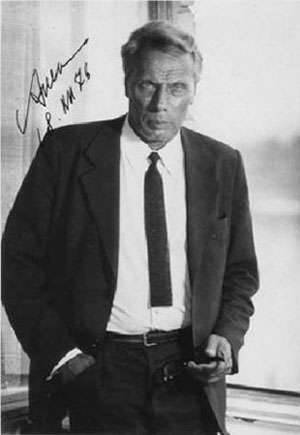 - We will swim along the Volga - we shall see, - Alekseev answered in such cases.
- We will swim along the Volga - we shall see, - Alekseev answered in such cases.The meeting with the fuel tank took place in one of the first flights. When the “Rocket” at full speed hit its wings on a large half-sunken log, Alekseev and the captain, who were at that time on the deck of the motor ship, turned pale with excitement. Calculations by calculations, all the same, there are all sorts of surprises, suddenly a log will ram the light, like an airplane, the hull of a river ship?
However, the passengers on the boat did not even feel the shaking of the hull. Steel wings, like sharp knives, instantly cut the log, and only large chips accidentally fell under the screw and slightly bent its blades.
The last days of navigation have arrived. The "rocket" was already without passengers from Gorky to the Kuibyshev reservoir, where, according to the forecast bureau, great excitement was expected. Alekseev wanted to experience the ship in the harshest stormy weather. But when the ship approached Kazan, it became very cold, freezing began on the Will. Moving on was not possible. “Salo” went along the river. Along the coast there are already areas of solid ice. There was a real danger - to find himself in ice captivity.
But the "Rocket" could not winter in Kazan, far from the Sormovsky backwater. But the cruise ship is not an icebreaker. What happens to his hull if the ship starts to break through the ice fields? Alekseev and Poluektov, all the designers who were aboard at that time, anxiously consulted whether they had the right to put their first cruise ship at such a risk. However, they didn’t have time for reflection, they had to decide immediately, until the situation on the river deteriorated.
Alekseev decided: to return to Gorky. From Kazan moved away at night. It was dark and deserted on the river, but there were lights showing up the fairway in some places.
Soon it began to snow, it became even darker. Then came the fog.
In such difficult conditions, the flight of the “Rocket” began along an almost frozen river - seven hours of continuous unrest and tremendous tension in an unusual cruise, on which only a winged ship could decide.
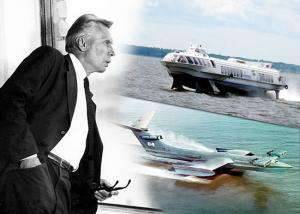 If the “Rocket” were sitting deep in the water, the ice floes would surely damage its hull. But the wings lifted the body of the ship into the air and instantly cut large pieces of ice. Small ice with a whistle flew through the entire motor ship, with a beating it beat about strong glasses of the windows of the cabin, about the dural lining of the deck, and it seemed like an ice blizzard raging above the winged ship.
If the “Rocket” were sitting deep in the water, the ice floes would surely damage its hull. But the wings lifted the body of the ship into the air and instantly cut large pieces of ice. Small ice with a whistle flew through the entire motor ship, with a beating it beat about strong glasses of the windows of the cabin, about the dural lining of the deck, and it seemed like an ice blizzard raging above the winged ship.On the half way, the water intake scored with ice, but there is a blessing in disguise: now the designers have learned how to redo it, so that no freeze will take them by surprise.
All in long icicles, which hung on the sides, frosty, as if grayed out over this heavy ice transition, the “Rocket” returned safely to Gorky to become a winter hut on the shores of factory grounds.
For “Rocket” Alekseev set about creating “Meteor”. The new ship "Meteor" was laid on the stands in January 1959. By the end of the year he was ready. Assembly was fast.
The winged ship, which seemed fantastic a few years ago, did not surprise anyone now, becoming the same familiar detail of the factory landscape as tugs, boats, motor ships.
And then “Sputnik”, “Voskhod”, “Petrel”, “Comet” appeared, which had already plowed the expanses of the sea.
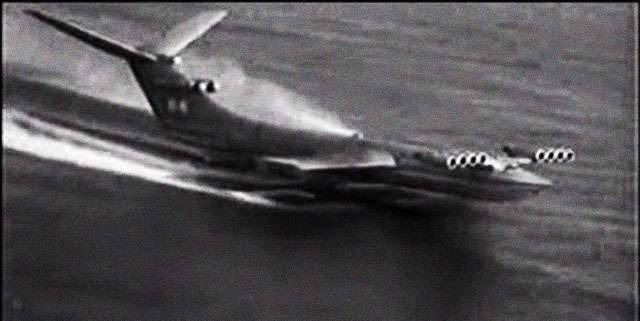
But few people know that Alekseev’s design bureau was actively developing military options - for example, ekranoplans “Lun” and “Eaglet”, which, in fact, open a new era in traditional systems aviation and fleet.
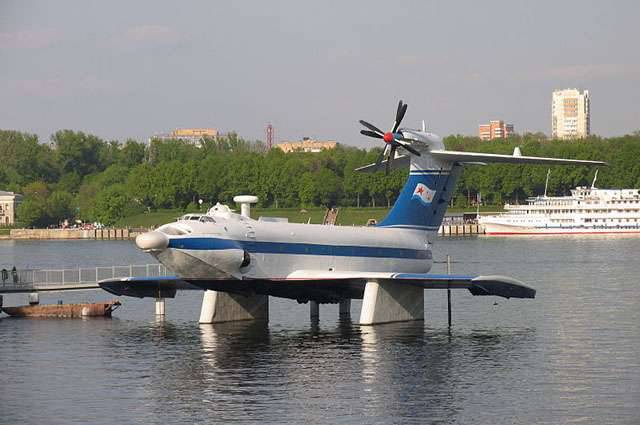
It is known that three ekranoplanes of the type “Orlyonok” were created for the needs of the Navy. The new Minister of Defense Sergey Sokolov in 1984 found these projects unpromising. But the general designer Alekseev will never find out about this: during the tests of the passenger version of an WIG, he will be under the weight of his brainchild. Nobody really could tell from his designer how Alekseev got under the ekranoplan. He will produce until the end of the test, and the next day he will complain of severe pain in the stomach. On the second day, Alekseev fainted. Doctors said he broke up. Peritonitis has begun. Save the ingenious designer failed.
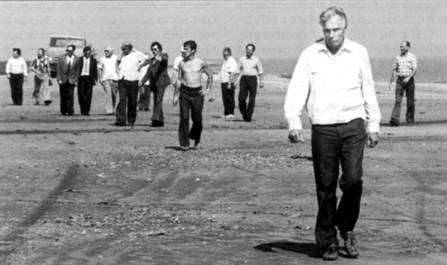
Information